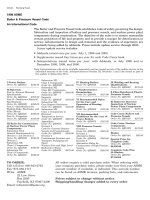Process Engineering Equipment Handbook Episode 1 Part 4 ppt
Bạn đang xem bản rút gọn của tài liệu. Xem và tải ngay bản đầy đủ của tài liệu tại đây (1.17 MB, 50 trang )
C
CAD/CAM (see also Machining)
CAD/CAM is an acronym for computer-automated design and computer-automated
machining. CAM is generally conducted in conjunction with computer numerical
control (CNC) for metal-working processes such as blade-tip robotic welding, CNC
tig welding, and CNC lathing, milling, and/or machining. All these numerical and
computational methods contribute to a field that is now a science in its own right.
See Metallurgy for information on blade-tip robotic welding, an example of a CNC
CA (in this case welding) process.
CFD (Computational Fluid Dynamics)*
CAD is frequently used in conjunction with computational fluid dynamics (CFD)
where air- or gasflow is involved. For illustrative purposes, some literature on CFD,
as a component of CAD, follows.
CFD can be used for analyzing, for instance
Fluid handling
Measurement and controls
Heat and mass transfer
Filtration
Distillation
Mixing
Separation
Fluidization
Sedimentation
Reaction
Polymerization
Drying
Forming
Ventilation
Emission control
Incineration
Combustion
Materials processing
C-1
*Source: Fluent Inc., USA. Adapted with permission.
C-2 CFD
FIG.
C-1 Streamlines depict the flow of regenerated catalyst through a slide valve, revealing the
source of erosion problems. Courtesy of REMOSA. (Source: Fluent Inc.)
FIG. C-2 Instantaneous solids concentration in a riser, showing how a baffle plate can be used to
distribute flow and produce uniform delivery of catalyst to the reactor. (Source: Fluent Inc.)
Figures C-1 through C-11 are modeling representations of eight individual case
studies.
The work done by CFD firms is frequently unique to a specific firm and any
research alliances it may have formed with individual OEMs.
Some Generic CFD Applications
Fluid handling and flow distribution
Transport and storage of gases, liquids, or slurries represents a large capital and
operating expense in process plants. CFD software helps to design for flow
uniformity, balance flows in manifolds, minimize pressure drop, design storage
tanks, and accurately size blowers, fans, and pumps. High-speed nozzles and spray
systems can be analyzed in order to optimize performance.
Reactor modeling
CFD software helps you to quantify residence times, mixing rates, scaling effects,
and overall chemical conversion in a wide range of reactor systems, including
packed beds, fluidized beds, recirculating beds, plug flow or tube reactors, and
stirred tank reactors. This provides the flexibility you need for description of
reactions and the sophistication you need for prediction of gas-solid, gas-liquid, or
liquid-solid multiphase systems.
Ventilation and safety
CFD software allows you to reliably and easily determine the trajectory of
environmental releases and examine building ventilation system performance. You
can quantify the exposure of personnel to specific contaminant levels and analyze
the effectiveness of planned responses.
Mixing
Mixing in agitated vessels, static mixers, jet mixers, t-mixers, and other devices
is important to the performance of most chemical and process plants. The capability
for the analysis of stirred tank mixers is unsurpassed, with interactive automated
model generation and mixing-specific data analysis tools.
Materials processing
Extrusion, mold filling, fiber forming, thermoforming, and coating processes involve
complex fluid rheology and deforming free surfaces that not all CFD codes can
CFD C-3
FIG.
C-3 Prediction of exhaust plume trajectories can provide quantitative information about
downstream impacts. (Source: Fluent Inc.)
model. CFD software includes powerful tools that are customized to excel for these
applications.
Separation and filtration
CFD can provide a complete range of tools for modeling of phase separation, solids
settling, and particle dispersion and classification. Inertial separation using
chevrons or cyclonic separators and filtration systems using filter media can also
be modeled.
Combustion, incineration, emissions, and environmental control
CFD can provide state-of-the-art models for prediction of combustion and pollutant
formation, including built-in NO
x
prediction. Optimization of environmental control
equipment, from incinerators to scrubbers, filters, and collectors, can help ensure
compliance and reduce capital costs.
Some Examples of Specific CFD Case Studies
This material is proprietary to the information source company and therefore
contains mention of trademarks specific to this designer.
Process industry modeling
The European Commission has funded the European office of this information
source to work on two projects related to process industry applications.
OLMES is a project that looks at the application of CFD to the design of
membrane separation devices used in the production of reformulated gasoline. To
date, the primary method available for olefin reduction in FCC-derived gasoline is
C-4 CFD
Prediction of extrudate shape. Inverse die design capability allows determination of the required
die lip (FIG. C-4) for a specified extrudate shape (FIG. C-5). (Source: Fluent Inc.)
4
5
CFD C-5
FIG. C-6 Flow streamlines in an electrostatic precipitator confirm the effectiveness of vanes for
improving uniformity of flow through the precipitator plates. (Source: Fluent Inc.)
FIG. C-7 Temperature prediction in the vicinity of two catalyst-impregnated particles, studied as
part of the CATAPOL project on the application of CFD to polymerization. (Source: Fluent Inc.)
FIG. C-8 Tetrahedral mesh used in IcePak 2.2 to model a complex fan/heat sink with radial fins.
(Source: Fluent Inc.)
the hydro-treating process. However, hydro-treatment is a very energy-intensive
process and significantly reduces octane quality. Membrane separation is now
becoming an attractive alternative, but many practical design problems remain.
The OLMES project aims to build simulation software that will aid the design
process by modeling the fluid flow and mass transfer in the many fine passageways
that make up a membrane separator.
CATAPOL is a project that applies CFD to the modeling of heterogeneously
catalyzed gas-phase polymerization, involving the injection of catalyst particles into
a fluidized bed where they react with monomer gas to grow polymer particles. Using
CFD modeling of individual particle behavior and fluidized bed hydrodynamics,
the project addresses potential problems such as reactor stability and thermal
runaway.
C-6 CFD
FIG.
C-9 The FLUENT/UNS prediction yielded good agreement with the measured heat addition
due to windage heating. (Source: Fluent Inc.)
FIG. C-10 Temperature prediction showing the effect of windage heating. (Source: Fluent Inc.)
FIG. C-11 Mesh adaption with embedding was used to ensure grid independence of the
predictions. (Source: Fluent Inc.)
10
11
New core technology for IcePak
IcePak, a specialty CFD product for electronics cooling applications, continues to
evolve at a fast pace. Jointly developed by this information source and ICEM CFD,
new releases of IcePak are delivering on the commitment to make this information
source’s latest core CFD technology available for electronics thermal management.
The first adaptation of this product, “Version 2.1,” released in October 1997,
delivered speed improvements by incorporating the solver engine from FLUENT/
UNS (an average of 7.5 times faster during regression testing).
The next adaptation of this product, “Version 2.2,” was intended to deliver more
flexible model building capability, with tetrahedral as well as hexahedral meshes
supported. Tetrahedral meshes can handle extremely complex geometries. The
combination of automated hex and tet meshing gives IcePak users better strategies
when confronted with difficult modeling.
Predicting windage heating in labyrinth seals
Labyrinth seals are commonly used in rotating equipment to restrict cooling flow
between rotating and stationary components. One of the issues in the design of such
seals is the accurate prediction of the temperature rise of the cooling flow due to
windage heating effects. Accurate prediction of this heating allows designers to
maintain the structural integrity of the engine with the minimum amount of cooling
flow, thereby maximizing the efficiency of the engine.
In order to validate the accuracy of this information source’s product
(“FLUENT/UNS”) for this kind of flow prediction, a straight five-fin labyrinth knife
seal with a nominal clearance of 1.11 mm between the labyrinth seal and the shroud
was analyzed. The computational model was axisymmetric, with specification of the
pressure ratio (1.5) across the seal as imposed boundary conditions. The working
fluid was assumed to be air, with density computed via the ideal gas law and fluid
properties (viscosity, thermal conductivity, and heat capacity) expressed as a
function of temperature. Turbulence was modeled using the RNG k-e model. The
CFD model was run at several different rotor speeds and the windage heating was
computed and compared with the experimental data.
Grid independence using adaption. Grid-independent solutions were obtained at
each operating speed by using the solution-based mesh adaption capability in
FLUENT/UNS. The mesh was adapted based on predicted y
+
values and on
gradients of total temperature. The initial mesh for each simulation started out
with approximately 9400 quadrilateral cells and after adaption the final cell count
was approximately 12,500 cells. A typical mesh after the solution-adaptive
refinement is shown below.
Carbon; Carbon-Graphite Mix Products
When mixed with graphite, carbon has lubricant-, strength-, and temperature-
resistance properties that are useful in many applications. The properties of the
mix depends on the variation in the mix, as well as the bonders and adhesives used.
These properties will therefore vary between companies that make these products.
For illustrative purposes, one company’s product line, with applications, is outlined
here.*
Carbon; Carbon-Graphite Mix Products C-7
*Source: Advance Carbon Products, USA. Adapted with permission.
Example of a Carbon Mix Material
AD-CARB is a self-lubricating, low-friction carbon material that has high
mechanical strength and can withstand temperatures up to 750°F without
oxidizing.
Through the impregnation of metals and/or resins, this material can solve many
lubrication problems. See Table C-1.
Product properties
1. Self-lubricating.
The product acts as an effective dry lubricant, forming a thin
film on mating parts, which allows the material to properly function without
additional lubrication. The product may be used with light lubrication to enhance
its load-carrying capabilities. The material is nongalling.
C-8 Carbon; Carbon-Graphite Mix Products
TABLE
C-1 AD-CARB Materials
Modulus of Temperature
Density, Shore Compressive Flexual C.T.E., Elasticity, Limit in
Grade Composition g/cm
3
Hardness Strength, psi Strength, psi in/in/°F ¥ 10
-6
psi ¥ 10
-6
Air, °F
AC-1 CG 1.59 40 8,000 3,600 2.5 1.7 700
AC-1F CG-R 1.75 55 11,000 5,000 3.0 1.9 400
AC-2 CG 1.71 60 11,000 6,700 2.5 2.0 700
AC-2F CG-R 1.80 70 15,000 8,000 3.0 2.2 400
AC-3 CG 1.66 50 12,000 4,600 2.4 1.7 700
AC-4 CG-R 1.75 65 20,000 6,000 2.9 1.9 400
AC-8 G 1.76 40 9,000 5,000 1.6 2.0 750
AC-9 G 1.64 35 4,000 1,900 2.2 1.6 750
AC-10 G 1.72 35 5,600 3,500 2.1 1.8 750
AC-20 G 1.78 45 9,300 4,300 2.3 1.6 750
AC-22 G 1.71 35 7,200 3,500 2.2 1.5 750
AC-23 G-P 1.71 35 7,200 3,500 2.2 1.5 750
AC-25 G 1.72 40 7,000 4,000 1.6 1.6 750
AC-26 G 1.70 45 8,000 4,500 2.6 1.5 750
AC-27 G 1.90 85 18,000 10,000 3.5 1.9 750
AC-30 G 1.81 45 9,000 4,800 1.4 1.5 750
AC-40 CG-B 3.00 40 13,000 6,000 2.3 2.9 400
AC-50 CG-BR 2.85 45 17,000 7,500 2.6 2.9 500
AC-52 CG-BR 2.55 60 25,000 8,500 2.6 3.1 500
AC-60 CG-CU 2.85 50 16,000 7,500 3.1 2.8 750
AC-62 CG-CU 2.50 60 24,000 8,500 3.0 2.8 750
AC-80 CG-AG 3.40 45 16,000 7,000 3.1 2.7 750
AC-82 CG-AG 2.60 65 24,000 8,000 3.0 2.9 750
AC-101 CG-NI 2.40 60 23,000 7,500 2.8 2.8 750
AC-106 CG-NI 2.85 50 15,000 6,500 2.7 3.1 750
AC-236 CG-R* 1.85 85 26,000 9,500 2.9 3.2 500
AC-240 CG 1.70 85 30,000 9,000 2.1 2.5 700
AC-243 G 1.85 90 33,000 12,000 2.8 3.0 850
AC-245 CG-AG 2.45 75 36,000 12,000 2.8 4.0 700
AC-246 CG-R 1.80 95 40,000 12,500 3.2 3.3 500
AC-250 CG 1.75 65 20,000 7,500 2.0 2.3 700
AC-253 CG-AT 2.10 75 27,000 10,000 2.3 3.9 700
AC-266 CG-BR 2.40 80 40,000 13,000 3.7 4.1 500
AC-270 C-B 2.40 65 26,000 10,000 3.7 3.0 400
AC-540 G 1.77 50 13,000 5,500 1.8 1.3 750
AC-562 G-P 1.88 70 21,000 14,000 4.3 1.6 850
Code: CG = Carbon-Graphite R = Resin CU = Copper NI = Nickel-Chrome
G = Graphite B = Babbitt AG = Silver * = Pressure Tight after Machining
P = Purified BR = Bronze AT = Antimony
2. Oxidization resistant. The product maintains its properties up to 750°F without
oxidizing. The material may be used up to 1500°F in an inert atmosphere,
depending upon which grade is used. Certain materials may be treated to operate
successfully up to 1100°F in an oxidizing atmosphere.
3. High mechanical strength. The product possesses high mechanical strength and
hardness to create a long-wearing material. The strength of the material actually
increases with an increase in temperature.
4. Chemical resistant. The product is chemically stable and does not react with most
chemicals: acids, alkalis, salts, and organic solvents.
5. Low coefficient of friction. The product has a coefficient of friction of
approximately 0.05 to 0.20, depending upon the lubrication and surface finish of
the mating surface.
6. Low coefficient of thermal expansion. The product has a coefficient of thermal
expansion of between 1.5 and 4.0 ¥ 10
-6
/°F, allowing for precisely controlled running
clearances from room temperature up to maximum operating temperature.
7. Material classification. The product is a mixture of carbon and graphite that may
be impregnated with various metals and resins to enhance the wear properties and
improve the life of the materials.
Design factors
1. Environment.
The carbon material and its impregnation must be checked to
ensure that they are compatible with the environment.
2. Temperature. Though carbon does increase in strength with an increase in
temperature, the maximum operating temperature of the material must not be
exceeded. When the maximum temperature is exceeded, carbon becomes soft on the
exposed surfaces from oxidization and will wear quite rapidly.
3. Mating materials. The product may be run against most materials with better
results when run against the harder surfaces. Ceramics and chrome-plated surfaces
are excellent mating materials. A minimum Rockwell C of 55 is recommended.
Longer life will also be obtained if the mating material is ground and polished to a
16 microinch finish or better.
4. Load. The bearing load, in pounds per square inch, is calculated by figuring the
total bearing load divided by projected area of the bearing (length ¥ diameter). The
maximum load that a bearing can withstand is related to the velocity (feet/minute)
by the following formula: PV = 15,000 (dry).
If the bearing is thoroughly lubricated, the PV may be increased up to 150,000
or more, depending upon the circumstances. See Fig. C-12.
5. Interference fit. Since carbon bearings are usually installed in metal housings
and run against metal shafts, the designer must be aware of the difference in the
coefficient of thermal expansion of the materials and take this into consideration
when designing the size of the bushing. At maximum operating temperature, the
bushing must have at least a 0.0015 in interference fit per inch of diameter.
Carbon; Carbon-Graphite Mix Products C-9
6. Close-in. When a carbon bearing is either pressed into a housing or heat-shrunk
into a housing, the inside diameter will shrink in relation to the amount of
interference on the outside diameter. This shrinkage must be taken into account
when designing the inside diameter. For heavy-wall bearings (approximately
1
/
2
in),
the inside diameter will shrink approximately 40 percent of the interference fit
on the outside diameter; for thin-wall bearings (approximately
1
/
8
in), the inside
diameter will shrink approximately 90 percent of the interference fit on the outside
diameter.
7. Running clearance. The running clearing will vary depending upon the
application requirements; however, a general guideline is to have 0.002 in/in of
shaft diameter with a minimum of 0.003 in. This minimum clearance is to allow
foreign particles to escape through the bushing, with minimal damage. These
clearances are measured after the bearing is installed in the housing to take into
account the inside diameter close-in. With high surface speeds the clearance may
be reduced, and with slow surface speeds the clearance may be increased.
8. Bearing length. The bearing length should be one to three times the shaft
diameter, with 1
1
/
2
times the preferred length.
9. Preferred design. The preferred design is for the bearing to be a straight sleeve
type without shoulders and grooves. Shoulders create stress points and can be a
cause of failure. Grooves can be used quite successfully if they are installed with a
radius tool bit and do not cut so deep into the wall as to weaken the bearing. The
C-10 Carbon; Carbon-Graphite Mix Products
FIG. C-12 Maximum allowable load for thoroughly lubricated bearings. Reduce load to 10 percent
of graph value for dry running. (Source: Advance Carbon Products.)
minimum wall thickness should be
1
/
8
in, with
3
/
16
in preferred. The recommended
wall thickness is
1
/
8
in + 10 percent of the bearing inside diameter. See Fig. C-13.
10. Tolerances. The product bearings can be machined to very close tolerances. The
recommended tolerances are listed below, though closer tolerances can be machined
at additional cost.
OD: ±0.001 in
ID: ±0.001 in
Length: ±0.010 in
Concentricity: 0.002 in TIR
Application example
Lube oil injection pump:
235°F operating temperature
316 stainless steel housing
316 stainless steel shaft, hard faced 0.020 deep, ground and polished
1770 rpm
3.092/3.090 housing diameter
2.4375 shaft diameter (maximum)
A. Material recommendation is AC-52, good up to 500°F.
B. Calculate expansion, close-in, and running clearance:
1. Housing: 316SS coefficient of thermal expansion is 8.3 ¥ 10
-6
in/in °F;
@ 235°F, stainless steel housing expansion =
(235–68°F) (3.092 dia.) (8.3 ¥ 10
-6
in/in °F) = 0.0043 in housing expansion
Carbon; Carbon-Graphite Mix Products C-11
FIG. C-13 Close-in of inside diameters (approximation due to press or shrink fit). (Source:
Advance Carbon Products.)
2. Bearing: AC-50 coefficient of thermal expansion is 2.6 ¥ 10
-6
in/in °F;
@ 235°F, carbon OD expansion =
(235–68°F) (3.092 dia.) (2.6 ¥ 10
-6
in/in °F) = 0.0010 in bearing expansion
3. Minimum interference fit =
0.0015 in/in of diameter
¥
3.092 in OD
0.0046 in min. OD Interference
4. Calculate OD:
+0.0043 Housing expansion
-
0.0010
Bearing expansion
=+0.0033 Expansion difference
add +0.0046
Minimum interference fit
=+0.0079 Total addition to OD
add +3.0920
Housing ID
=+3.0999 Bushing OD, minimum
Since the housing has a 0.002 in tolerance, the tolerance for the bearing should
be reduced to 0.001 in, so as to prevent a buildup of excessive tolerances.
Final bushing OD = 3.100, +0.001, -0.000.
5. Close-in of ID at room temperature, due to press fit:
Calculate minimum and maximum interference fits:
Minimum:
3.100 Minimum bearing diameter
-3.092
Maximum housing
diameter
=0.008 Minimum interference
¥80%
Close-in
percentage
= 0.0064 Minimum close-in
Maximum:
3.101 Maximum bearing diameter
-3.090 Minimum housingdiameter
= 0.011 Maximum interference
¥80% Close-inpercentage
= 0.0088 Maximum close-in
0.0088/0.0064 = 0.0076 average close-in
6. Running clearance:
2.4375 in shaft diameter
¥0.002 in clearance/in of shaft diameter
= 0.0049 minimum running clearance
7. Calculate bearing ID:
Bearing close-in = +0.0076 in
Running clearance =+0.0049 in
High-limit shaft diameter= +2.4375 in
Inside diameter =+2.450 in (tolerance: ±0.001)
8. Bearing length:
Shaft diameter 2.4375 in
¥1.5ratio
3.656 in preferred length
Seals
Mechanical seals are custom machined to a specification. Note: Material
specifications stated here are typical values, and will vary with the size of the
material.
C-12 Carbon; Carbon-Graphite Mix Products
Products that can be made with carbon-based materials:
Brushes: motor/generator
Carbon
Electrographitic
Metal-graphite
Graphite
Brush holders
Brush seater and cleaner
Brush tension scales
Carbon specialties
Seals
Steam turbine seals
Gas turbine seals
Hydraulic turbine seals
Labyrinth seals
Spherical seals
Compressor seals
Pump and compressor blades
Bearings
Thrust bearings
Sliding guides
Porous carbon filters
Commutator dressing and finishing stones
Electrical contacts
Graphite
Silver-graphite
Copper-graphite
Metal impregnated carbon—graphite
Carbon Dioxide (CO
2
); CO
2
Disposal
Carbon dioxide, an inert gas, is a byproduct of combustion. Large volumes of
CO
2
result from combustion of fossil fuels. Industrial users of fossil fuels include
gas and steam turbines. Industrial activity has contributed increasing volumes of
CO
2
to the atmosphere. CO
2
has been found to be a greenhouse gas. Greenhouse
gases contribute to the phenomenon of global warming. There have been changes
in atmospheric CO
2
content that have “corrected themselves” in planetary history,
but those changes occurred over millions of years versus the current trend
established over just a few centuries. Technologies are now being developed to
remove CO
2
from atmospheric solution to lessen the amount of CO
2
released into
the atmosphere.
Due to chemical composition (number of atoms of carbon in a molecule of fuel),
some fuels produce less CO
2
on a unit-weight basis than others that may be more
commonly accepted on the market. This is one of the best ways of mitigating
emissions of this greenhouse gas.
Research project activity in the field of CO
2
mitigation includes liquefication of
CO
2
experiments (liquid CO
2
can be used in dry cleaning). There may eventually
Carbon Dioxide (CO
2
); CO
2
Disposal C-13
also be an industrial grade process to solidify CO
2
by “turning” it into limestone or
calcium carbonate. What follows is a description of an industrial process developed
in Sweden, where CO
2
resulting from fossil fuel combustion is reinjected into the
ground.
Technology and Cost Options for Capture and Disposal of Carbon Dioxide from Gas Turbines:
A System Study for Swedish Conditions*
The current massive dependency on fossil fuels—90 percent of the world
population’s commercial production and consumption of energy—together with
predictions of a considerable increase in the total world energy consumption during
the coming decades, implies that the emissions of carbon dioxide from human
activities will rise significantly over that period. Carbon dioxide (CO
2
) is the largest
anthropogenic contributor to the greenhouse effect. There is a broad consensus
among scientists that the current and increased CO
2
emissions will increase the
global mean temperature and affect local climates significantly, with numerous and
far-reaching economic and environmental consequences.
Among several options for limiting future CO
2
emissions, capture and disposal of
CO
2
from combustion gases has been studied within the IEA Greenhouse Gas
Implementing Agreement. The process components of CO
2
capture have been
demonstrated, and a complete demonstration plant (200 ton CO
2
per day recovered
from boiler flue gases) is in operation at Shady Point in the United States (formerly
ABB Lummus Crest; as of 2000, ABB is part of the Alstom Corporation). Disposal
of CO
2
into sandstone aquifers is now under demonstration on a commercial scale.
Since 1996, Statoil injects 1 million ton CO
2
per year into the Utsira sandstone
formation at the Sleipner natural gas field.
Financed by NUTEK (The Swedish National Board for Industrial and Technical
Development), a system study has been performed with the objective to assess how
recent knowledge on the technical and economic options for the capture and the
disposal of CO
2
from combustion gases could be implemented into the Swedish
energy system.
Aquifers suitable for disposal of carbon dioxide
Surveys of earlier geologic investigations have indicated that geologic formations—
aquifers—that should be suitable for CO
2
disposal exist in the south of Sweden–
Denmark (South West Skåne and the eastern part of Zealand) and in the Baltic Sea
between Gotland and Lithuania. The aquifer in Skåne-Denmark has the most
favorable location with an estimated storage capacity of up to 10 Gton CO
2
of which
the part in Skåne is estimated to have a storage capacity of up to 3.5 Gton. This
could be compared to the yearly Swedish CO
2
emissions, approximately 60 Mton in
1995.
Capture of carbon dioxide from gas turbine–based power plants
Large-scale electric power production (500 MW power) with CO
2
capture has been
studied for natural gas combined cycle (NGCC) and coal-based integrated
gasification combined cycle (IGCC) within the IEA Greenhouse Gas R&D
Programme. Based on these studies, we have studied the possibilities of recovering
C-14 Carbon Dioxide (CO
2
); CO
2
Disposal
* Source: Vattenfall Utveckling AB, Sweden; also, this section is adapted from extracts from ASME paper
98-GT-443.
low-temperature heat from such processes as district heating. As a reference to the
IGCC, performance and costs for pulverized coal combustion (PF, pulverized fuel)
with and without CO
2
capture have also been estimated.
The process configurations, CO conversion rates, CO
2
removal efficiencies and
other process parameters are the same as in IEA studies. Almost all process steps
are based on proven technologies, and the process parameters have been chosen
based on typically feasible designs and performances.
The NGCC plant consists of a single train of an advanced gas turbine. Like in
some IEA studies, the calculations have been based on a Siemens 94.3A (turbine
inlet temperature 1300°C and pressure ratio of 15–16) with a triple pressure reheat
steam cycle (106 bar/30 bar/4.5 bar) (Fig. C-14). Due to the low partial pressure in
the gas turbine exhaust gas, a CO
2
removal process based on chemical absorption,
using a solvent such as MEA (MonoEthanol Amine), will be required. The assumed
CO
2
removal efficiency is 85 percent. Regeneration of the solvent is performed by
reboiling and stripping. Low-pressure steam for the regeneration is extracted from
the steam cycle.
In the IGCC plant, coal is gasified at a high pressure (about 50 bar) and
temperature (about 1400°C) with oxygen and steam in an entrained flow gasifier
(Fig. C-15). In an IGCC plant without CO
2
capture, the fuel gas would be cooled
and contaminants, such as dust and hydrogen sulfide, would be removed before
burning the gas in the gas turbine combustor.
Due to its higher pressure and lower gas flow, it is advantageous to capture CO
2
in the fuel gas upstream of the gas turbine instead of from the exhaust gases. The
fuel gas contains about 40 vol% CO, 28 vol% H
2
, 18% H
2
O, and 10 vol% CO
2
. Since
the CO (carbon monoxide) in the fuel gas would be emitted as CO
2
in the gas turbine
exhaust gas, it must be converted to CO
2
prior to the CO
2
removal. This is achieved
with steam according to the shift reaction, CO + H
2
O ¤ CO
2
+ H
2
. Medium pressure
steam is extracted from the steam cycle. The steam demand is 0.5 kg H
2
O/kg gas.
The shift takes place in multiple catalytic reactors with intercooling at about
250–350°C.
After the sift, the CO
2
content in the gas has increased to 30 vol%. Because of the
high pressure and concentration, a CO
2
removal process based on physical
absorption, like the Selexol process, is most suitable for this application. The
Carbon Dioxide (CO
2
); CO
2
Disposal C-15
FIG.
C-14 Process scheme for an NGCC (natural gas combined cycle) power plant with CO
2
capture. (Source: Vattenfall
Utveckling AB.)
removal efficiency is assumed to be 90 percent. Hydrogen sulfide is selectively
removed before the CO
2
removal. The sulfur-rich gas is transferred to a Claus unit,
where elementary sulfur is produced. Regeneration of the absorbent is achieved by
temperature increase and flashing. Low-pressure steam for the regeneration is
extracted from the steam cycle. The dry isolated CO
2
is pressurized and liquefied.
After CO
2
removal, the hydrogen-rich fuel gas is burned in a gas turbine. A
hydrogen-rich gas would most likely be a good gas turbine fuel. The gas turbine
combustor must, of course, be designed for this type of fuel gas, since hydrogen has
somewhat different combustion characteristics than natural gas. Combustion of
hydrogen/steam mixtures for utilization in future advanced gas turbine cycles is
investigated by Westinghouse. As in an IEA study, a Siemens V94.4 gas turbine has
been assumed.
Carbon dioxide neutral coproduction of methanol, power, and district heating
Carbon dioxide neutral production and utilization of methanol as an automotive
fuel for the transport sector integrated with production of electric power and district
heat could be achieved with biomass combined with natural gas or coal as a raw
material. An amount of CO
2
corresponding to the carbon in the fossil fuel then has
to be captured and disposed into, e.g., an aquifer. Examples of a few such options
C-16 Carbon Dioxide (CO
2
); CO
2
Disposal
FIG.
C-15 Process scheme for a coal-based IGCC (integrated gasification combined cycle) power plant with shift
(conversion of CO to CO
2
) and CO
2
capture upstream of the gas turbine combustion chamber. (Source: Vattenfall Utveckling
AB.)
have been studied based on IEA studies, other literature, and Vattenfall in-house
information.
Co-gasification of biomass and coal. Coal and biomass are gasified in an entrained
flow gasifier at 1400°C, 40 bar with oxygen and steam (Fig. C-16). Before being
gasified, the biomass is dried in a steam drier, lowering its moisture content from
about 50 percent to 10 percent, followed by milling. The air separation unit (ASU)
is based on cryogenic separation. The syngas generated in the gasifier is cooled and
cleaned from dust and sulfur. Heat is extracted to be used in the steam cycle.
The syngas contains about 28 vol% H
2
and 39 vol% CO at the inlet of the methanol
synthesis reactor. Since both biomass and coal have low hydrogen contents, a novel
methanol synthesis process under development by Chem. Systems/Air Products in
the U.S., called LPMeOH (Liquid Phase Methanol Synthesis), has been selected.
This process is less sensitive to the inlet syngas composition—mainly the ratio of
(H
2
- CO
2
)/(CO + CO
2
)—than the current commercially available methanol
synthesis processes. It has been assumed that 20 percent of the carbon input in
the fuel is converted to methanol. Assuming only CO reacts according to CO + 2H
2
Æ CH
3
OH, the CO conversion is 25 percent on a molar basis. The methanol
synthesis reaction is highly exothermic, and the released heat is utilized in the
steam cycle.
The unreacted outlet gas from the methanol synthesis reactor contains mainly
CO and H
2
O. By adding steam, the CO is converted to CO
2
according to CO + H
2
O
¤ H
2
+ CO
2
in the shift reactors. Like in an IGCC power plant case, a 95 percent
conversion of CO has been assumed. The CO
2
content in the gas then increases from
14 vol% to 44 vol%. CO
2
is captured in a Selexol plant. The removal efficiency has
been assumed to be 87 percent, which is close to the assumption for the IGCC power
plant case.
After the CO
2
removal, the remaining gas rich in H
2
is burned in the gas turbine
combustor. The gas turbine has been scaled to the actual fuel gas capacity from the
Siemens V 94.4 gas turbine in the IGCC case, assuming unchanged performance.
Heat from the gas turbine exhaust gases is utilized to generate steam for the
bottoming cycle in a heat recovery boiler.
Carbon Dioxide (CO
2
); CO
2
Disposal C-17
FIG. C-16 CO
2
neutral production of methanol, power and district heat by co-gasification of
biomass and coal combined with CO
2
capture. (Source: Vattenfall Utveckling AB.)
Gasification of biomass and reforming of natural gas in series. In this configuration,
syngas is produced from biomass, oxygen, and steam in a fluidized bed gasifier at
about 950°C, 20 bar. Before being gasified, the biomass is dried in a steam drier,
lowering its moisture content from about 50 percent to 15–20 percent. The syngas
from the gasifier is cleaned from dust using a ceramic filter at about 500°C and is
then mixed with syngas from a natural gas reformer. Since both the gasifier and
the reformer are operating at about 20 bar, the syngas mixture must be compressed
before entering the methanol synthesis reactor. Since the gas composition is not
optimal for a conventional methanol synthesis process, the LPMeOH process has
been selected (Fig. C-17).
The unreacted outlet gas from the methanol synthesis reactor is shifted before
the CO
2
removal. The CO
2
content in the gas then increases from 7 to about
18 vol%. Like in the IGCC power plant case, a 90 percent removal has been
assumed. The remaining gas, rich in hydrogen (69 vol%), is expanded to the
pressure required for the gas turbine combustor. The gas turbine has been scaled
to the actual fuel gas capacity from the Siemens V 94.4 gas turbine in the IGCC
case, assuming unchanged performance. The heat from the gas turbine exhaust gas
is utilized in the steam cycle and for heating the reformer.
Energy efficiencies and costs when capturing carbon dioxide
The calculated efficiencies with and without CO
2
capture for the gas turbine–based
power plants and for the described examples of CO
2
neutral coproduction of
methanol, electric power, and district heat are summarized in Table C-2. Additional
costs, due to the CO
2
capture, were estimated based on data from IEA studies, other
literature, and this information source’s in-house information. The results are
summarized in Table C-2.
CO
2
capture and recovery consumes electricity and energy at high temperatures
at the same time as energy at low temperatures can be recovered. This does not
C-18 Carbon Dioxide (CO
2
); CO
2
Disposal
FIG.
C-17 CO
2
neutral production of methanol, power, and district heat by gasification of biomass
and reforming of natural gas in series combined with CO
2
capture. (Source: Vattenfall Utveckling
AB.)
mean a total energy loss for a power plant, but since a smaller fraction of the total
energy will be available at higher temperatures (exergy loss), and a larger fraction
will be available at lower temperatures, the electric efficiencies will be reduced.
With the numerous district heating networks in Sweden, this means that it could
be possible to compensate for the losses of electric efficiency by recovering energy
at low temperatures as district heating. If sufficient quantities of low temperature
heat can be sold, the total efficiencies will be nearly the same as for the
corresponding power plants without capture of CO
2
.
The calculated capture costs per metric ton CO
2
become higher for lower capture
capacities than for higher capacities, which shows the scale economy for the capture
and recovery process parts.
The estimated costs per ton CO
2
for the methanol and electricity cases are higher
than for the power plants with similar capture capacities. This is due mainly to the
choices of credits for methanol and electric power. Both these credits reflect natural
gas–based production, which is less complex and therefore less costly than when
solid fuels—biomass and/or coal—are used. At the same time, the capture costs per
MWh (electricity + methanol) become about the same or lower as for the power
plants. The main reason for this is that substantial fractions of the total fuel inputs
Carbon Dioxide (CO
2
); CO
2
Disposal C-19
TABLE
C-2 Calculated Efficiencies and Carbon Dioxide Capture Costs for Electric Power Plants and for Carbon
Dioxide Neutral Coproduction of Methanol, Electric Power, and District Heating
Capital costs: 7 percent real interest rate, 20 years economic lifetime
Fuel costs: Natural gas 100 SEK/MWh, coal 50 SEK/MWh, biomass 120 SEK/MWh
District heat credit: 150 SEK/MWh
For Methanol and Electricity
Methanol credit: 230 SEK/MWh (assumed world market price 1 SEK/liter)
Electric power credit: 280 SEK/MWh (calculated production cost from natural gas without CO
2
capture)
Power Plant Methanol + Electricity
6000 h/year 8000 h/year
Biomass, MW (LHV) 385 385
Fossil Fuel, Natural Coal Fossil Fuel, Natural Gas Coal
MW (LHV) Gas IGCC MW (LHV) 1245 870
645 870
Methanol prod., MW 280 365
Net electricity, MW 300 320 Net electricity, MW 505 350
District heating, MW 55 85 District heating, MW 90 45
Net efficiencies Net efficiencies
Without CO
2
Capture With CO
2
Capture
Electric power, % 56 43 Methanol, % 17 29
With CO
2
Capture
Electric power, % 47 37 Electric power, % 31 28
District heating, % 7 10 District heating, % 6 4
Total, % 54 47 Total, % 54 61
Captured CO
2
, tons/h 120 260 Captured CO
2
, tons/h 260 315
CO
2
Capture Costs CO
2
Capture Costs
SEK/ton CO
2
220 100 SEK/ton CO
2
340 145
SEK/MWh el 150 110 SEK/MWh (el + methanol) 110 65
190
(IGCC
with -PE
without)
are biomass and only the CO
2
corresponding to the carbon in the fossil fuel input
is captured. The quantities of captured CO
2
then become smaller in relation to the
quantities of methanol plus electricity than the quantities of captured CO
2
in
relation to the quantities of electricity produced in the power plants.
The most economic power production process for coal without CO
2
capture is PF
(pulverized coal combustion) with a supercritical steam cycle. Its electric efficiency
is today almost as high as the efficiency for an IGCC. With CO
2
capture, the steam
consumption, auxiliary power need and cost for CO
2
capture from a boiler flue
gas with low CO
2
concentration (requires chemical absorption) are higher than for
CO
2
capture from a pressurized fuel gas with high CO
2
concentration (physical
absorption will be sufficient). Consequently, the loss of electric power efficiency and
the cost increase for CO
2
capture become substantially lower for an IGCC than for
a PF. This results in IGCC being the most economic coal-based power process with
CO
2
capture, also achieving the highest electric efficiency.
Transport and disposal of carbon dioxide
Captured CO
2
could be transported into an aquifer using a pipeline, ship, or possibly
a train. A pipeline is more economic than ship (or train) for shorter distances, while
ship transport seems to be the most feasible option for longer distances. However,
for larger CO
2
quantities, pipelines may be the most economic option also for longer
distances. The transport costs per ton CO
2
vary due to the distance and the
quantities. To give an idea of these costs, estimated transport costs for two cases,
a 40-km pipeline and a 700-km ship transport are shown in Table C-3.
The costs for injection of CO
2
into an aquifer have been estimated to
60–70 SEK/ton CO
2
(“SEK” is Swedish kroner) for a few studied examples based
mainly on data from Danish studies on aquifer disposal.
Examples of total costs for capture, transport, and disposal of carbon dioxide
The estimated total cost for capture and recovery, transport, and injection into an
aquifer of CO
2
consequently vary depending on energy production process, transport
distance, and the scale—especially for the CO
2
transport. This is illustrated in Table
C-4.
C-20 Carbon Dioxide (CO
2
); CO
2
Disposal
TABLE
C-3 Estimated Examples of Transport Costs for Carbon
Dioxide (Ekström, 1997)
Pipeline Ship
Distance, km 40 700
Quantity of transported CO
2
, tons/h 120 90
Transport cost, SEK/ton CO
2
20 110
TABLE C-4 Summary of Estimated Costs for the Capture, Transport, and Disposal of
Carbon Dioxide
Power Plants Methanol and Electricity Plants
300–320 MW el 715–785 MW (el + methanol)
6000 h/year 8000 h/year
Captured CO
2
, tons/h 120–260 260–315
Capture and Recovery of CO
2
, SEK/ton CO
2
100–220 145–340
Transport to Aquifer (40–700km), SEK/ton CO
2
20–110
Injection into Aquifer, SEK/ton CO
2
60–70
For most of the studied cases, the estimated total costs are in the same order of
magnitude as the current carbon dioxide tax in Sweden (365 SEK/ton CO
2
).
If the distance to a suitable aquifer is long, the CO
2
transport costs can be
significantly reduced, by collecting the captured CO
2
from more than one energy-
producing plant into one high-capacity pipeline, because of the favorable economy
of scale for pipeline transport.
Conclusions
Conclusions from the study are:
Capture and disposal of CO
2
may be considered as one of the opportunities to
reduce the total Swedish CO
2
emissions.
The total estimated costs per ton CO
2
captured and disposed are, with the
assumptions used, of the same order of magnitude as the current Swedish
CO
2
taxes. Plant owners will have to be credited for the captured and disposed
CO
2
in order to make this option economically justifiable and interesting for
them.
The process steps for CO
2
capture and recovery are well-proven and large-scale
natural gas or coal-fired gas turbine–based power plants with CO
2
capture could
be constructed using commercially available techniques.
Pipeline transport of CO
2
is practiced. Large-scale ship or train transport systems
are not developed for CO
2
.
Injection and disposal of CO
2
into aquifers is now at full-scale operation in the
North Sea.
The costs for CO
2
capture vary depending mainly on energy conversion process
and scale. Ongoing process developments are likely to improve the economy.
It will be important for the total economy to find favorable combinations of energy
conversion, CO
2
capture and recovery, transport, and disposal. There is also a
need to reduce uncertainties in the available basis for estimation of costs for large-
scale transport, injection, and disposal of CO
2
into aquifers.
For power plants, the losses of electric power efficiencies due to CO
2
capture could
be compensated for in terms of maintaining total energy efficiencies, if sufficient
quantities of district heat could be sold. The heat quantities produced for the plant
capacities chosen in this study are likely to be suitable for a reasonable number
of Swedish district heating networks.
The CO
2
emissions from the transport sector could be reduced by combining CO
2
capture with the production of automotive fuel (methanol), electric power, and
heat from biomass combined with natural gas or coal. Optimization work is
needed to find the most favorable process configurations.
Favorably localized aquifers that should be suitable for CO
2
disposal and with a
substantial storing capacity exist in South West Skåne-Denmark (eastern part of
Zealand).
Several aspects need to be clarified regarding aquifer conditions, disposal, and
large-scale CO
2
transport in order to make more accurate assessments. Swedish–
Norwegian–Danish cooperation projects regarding further clarification of
techniques and geology for aquifer disposal and large-scale CO
2
transport systems
would be beneficial.
A Swedish implementation of capture and disposal of CO
2
from combustion of
fossil fuels will require political decisions and development of legal frameworks.
The investigations of these aspects were outside the scope of this study.
Carbon Dioxide (CO
2
); CO
2
Disposal C-21
Castings (see Metallurgy)
Cells
Chemical cells are a specialized, often custom-designed item, common in
applications such as metallurgical processes, for example, electroplating. See Some
Commonly Used Specifications, Codes, Standards, and Texts.
Cement; Portland Cement
Cement is made by several companies around the world to exact standard
specifications. When mixed with varying grades of air, aggregate, and soil, concrete
of varying strengths is produced. Extracts from American Society for Testing and
Materials (ASTM) specification C 150-95 for Portland cement follow.
The manufacture of cement raises significant environmental concerns, and
standards have been developed around these considerations. Extracts from a
paper that describes cement manufacture in Canada and Canada’s emission
guidelines with respect to cement manufacturing kilns, also follows. Specifications
will vary slightly from country to country. Legislation, such as U.S.–Canada Air
Agreements and global conventions on issues such as air quality and global
warming (e.g., Kyoto, Rio, Montreal) are helping introduce communality into
specifications of products that affect air emissions, such as cement.
Extracts from Standard Specification for Portland Cement, ASTM C 150-95
1
This standard is issued under the fixed designation C 150; the number immediately
following the designation indicates the year of original adoption or, in the case of
revision, the year of last revision. A number in parentheses indicates the year of
last reapproval. A superscript epsilon (e) indicates an editorial change since the last
revision or reapproval.
This standard has been approved for use by agencies of the Department of
Defense. Consult the DoD Index of Specifications and Standards for the specific
year of issue which has been adopted by the Department of Defense.
1. Scope
1.1 This specification covers eight types of Portland cement, as follows (see Note
1 in section 4 below):
1.1.1 Type I—For use when the special properties specified for any other type are
not required.
1.1.2 Type IA—Air-entraining cement for the same uses as Type I, where air-
entrainment is desired.
1.1.3 Type II—For general use, more especially when moderate sulfate resistance
or moderate heat of hydration is desired.
1.1.4 Type IIA—Air-entraining cement for the same uses as Type II, where air-
entrainment is desired.
1.1.5 Type III—For use when high early strength is desired.
1.1.6 Type IIIA—Air-entraining cement for the same use as Type III, where air-
entrainment is desired.
C-22 Castings
1
This specification is under the jurisdiction of ASTM Committee C-1 on Cement and is the direct
responsibility of Subcommittee C01.10 on Portland Cement. Current edition approved June 15, 1995.
Published August 1995. Originally published as C 150-40 T. Last previous edition C 150-94b.
1.1.7 Type IV—For use when a low heat of hydration is desired.
1.1.8 Type V—For use when high sulfate resistance is desired.
1.2 When both SI and inch-pound units are present, the SI units are the
standard. The inch-pound units are approximations listed for information only.
2. Referenced documents
2.1 ASTM Standards:
C 33 Specification for Concrete Aggregates
2
C 109 Test Method for Compressive Strength of Hydraulic Cement Mortars
(Using 2-in. or 50-mm Cube Specimens)
3
C 114 Test Methods for Chemical Analysis of Hydraulic Cement
3
C 115 Test Method for Fineness of Portland Cement by the Turbidimeter
3
C 151 Test Method for Autoclave Expansion of Portland Cement
3
C 183 Practice for Sampling and the Amount of Testing of Hydraulic Cement
3
C 185 Test Method for Air Content of Hydraulic Cement Mortar
3
C 186 Test Method for Heat of Hydration of Hydraulic Cement
3
C 191 Test Method for Time of Setting of Hydraulic Cement by Vicat Needle
3
C 204 Test Method for Fineness of Hydraulic Cement by Air Permeability
Apparatus
3
C 226 Specification for Air-Entraining Additions for Use in the Manufacture of
Air-Entraining Portland Cement
3
C 266 Test Method for Time of Setting of Hydraulic Cement Paste by Gillmore
Needles
3
C 451 Test Method for Early Stiffening of Portland Cement (Paste Method)
3
C 452 Test Method for Potential Expansion of Portland Cement Mortars Exposed
to Sulfate
3
C 465 Specification for Processing Additions for Use in the Manufacture of
Hydraulic Cements
3
C 563 Test Method for Optimum SO
3
in Portland Cement
3
C 1038 Test Method for Expansion of Portland Cement Mortar Bars Stored in
Water
3
3. Terminology
3.1 Definitions:
3.1.1 Portland cement—a hydraulic cement produced by pulverizing clinker
consisting essentially of hydraulic calcium silicates usually containing one or more
of the forms of calcium sulfate as an interground addition.
3.1.2 Air-entraining portland cement—a hydraulic cement produced by
pulverizing clinker consisting essentially of hydraulic calcium silicates, usually
containing one or more of the forms of calcium sulfate as an interground
addition, and with which there has been interground an air-entraining
addition.
4. Ordering information
4.1 Orders for material under this specification shall include the following:
4.1.1 This specification number and date,
Cement; Portland Cement C-23
2
Annual Book of ASTM Standards, Vol. 04.02.
3
Annual Book of ASTM Standards, Vol. 04.01.
4.1.2 Type or types allowable. If no type is specified, Type I shall be
supplied,
4.1.3 Any optional chemical requirements from Table C-6, if desired,
4.1.4 Type of setting-time test required, Vicat or Gillmore. If not specified, the
Vicar shall be used,
4.1.5 Any optional physical requirements from Table C-8, if desired.
NOTE 1—Attention is called to the fact that cements conforming to the
requirements for all types may not be carried in stock in some areas. In advance of
specifying the use of other than Type I cement, it should be determined whether
the proposed type of cement is or can be made available.
5. Additions
5.1 The cement covered by this specification shall contain no addition except as
follows:
5.1.1 Water or calcium sulfate, or both, may be added in amounts such that the
limits shown in Table C-5 for sulfur trioxide and loss-on-ignition shall not be
exceeded.
5.1.2 At the option of the manufacturer, processing additions may be used in the
manufacture of the cement, provided such materials in the amounts used have been
shown to meet the requirements of Specification C 465.
5.1.3 Air-entraining portland cement shall contain an interground addition
conforming to the requirements of Specification C 226.
6. Chemical composition
6.1 Portland cement of each of the eight types shown in section 1 above shall
conform to the respective standard chemical requirements prescribed in Table C-5.
In addition, optional chemical requirements are shown in Table C-6.
7. Physical properties
7.1 Portland cement of each of the eight types shown in section 1 above shall
conform to the respective standard physical requirements prescribed in Table C-7.
In addition, optional physical requirements are shown in Table C-8.
8. Sampling
8.1 When the purchaser desires that the cement be sampled and tested to verify
compliance with this specification, sampling and testing should be performed in
accordance with Practice C 183.
8.2 Practice C 183 is not designed for manufacturing quality control and is not
required for manufacturer’s certification.
9. Test methods
9.1 Determine the applicable properties enumerated in this specification in
accordance with the following test methods:
9.1.1 Air Content of Mortar—Test Method C 185.
9.1.2 Chemical Analysis—Test Methods C 114.
9.1.3 Strength—Test Method C 109.
9.1.4 False Set—Test Method C 451.
9.1.5 Fineness by Air Permeability—Test Method C 204.
9.1.6 Fineness by Turbidimeter—Test Method C 115.
9.1.7 Heat of Hydration—Test Method C 186.
C-24 Cement; Portland Cement









